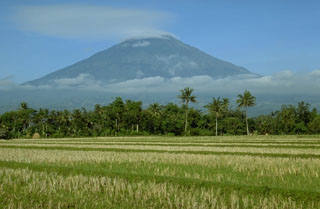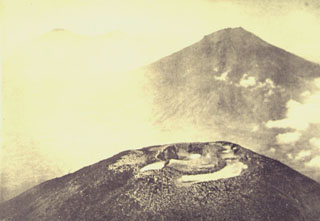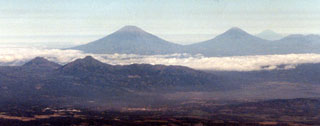

Based on pilot observations, the Darwin VAAC reported that an eruption plume from Sumbing rose to an altitude of 4.9 km (16,000 ft) a.s.l. and drifted W. Ash was not identified on satellite imagery. [Correction: CVGHM later confirmed that Sumbing did not erupt on 1 August and attributed the plume origin to either a different volcano or a bushfire that was reported in the area.]
Source: Darwin Volcanic Ash Advisory Centre (VAAC)
False report of an eruption plume in August 2008
The announcement of an eruption in the Smithsonian/USGS Weekly Volcanic Activity Report (30 July-5 August 2008) was later found to be false. The Darwin Volcanic Ash Advisory Center (VAAC) noted that a pilot reported an eruption plume from Sumbing on 1 August 2008. The plume allegedly rose to an altitude of 4.9 km and drifted W. However, ash was not identified on satellite imagery. Center of Volcanology and Geological Hazard Mitigation (CVGHM) observers at the local observatory saw only non-eruptive processes at the volcano, and they noted brush fires in September and October. A common problem in this active region occurs when drifting plumes become linked to the wrong volcano. After discussing the field observations, both Darwin VAAC and Indonesia's CVGHM concluded the report was in error. No thermal anomalies have been detected by the MODIS/MODVOLC satellite system for the volcano since 5 October 2006.
The area of Mt. Sumbing, close to Mt. Sundoro (also known as Sindoro) on Java (figure 1), was the subject of a recent study of people's perceptions and reactions to volcanic hazards (Lavignea and others, 2008). Note that there is another stratovolcano named Sumbing on Sumatra. In addition, one of the domes of Kelut (Java) is known as Sumbing.
Reference. Lavignea, F., De Costerb, B., Juvinb, N., Flohicb, F., Gaillardc, J-C., Texierd, P., Morine, J., and Sartohadif, J., 2008, People's behaviour in the face of volcanic hazards: Perspectives from Javanese communities, Indonesia: Journal of Volcanology and Geothermal Research, v. 172 (3-4), p. 273-287.
Information Contacts: Darwin Volcanic Ash Advisory Centre (VAAC), Bureau of Meteorology, Northern Territory Regional Office, PO Box 40050, Casuarina, NT 0811, Australia (URL: http://www.bom.gov.au/info/vaac/); Center of Volcanology and Geological Hazard Mitigation (CVGHM), Saut Simatupang, 57, Bandung 40122, Indonesia (URL: http://vsi.esdm.go.id/).
2008: July
Based on pilot observations, the Darwin VAAC reported that an eruption plume from Sumbing rose to an altitude of 4.9 km (16,000 ft) a.s.l. and drifted W. Ash was not identified on satellite imagery. [Correction: CVGHM later confirmed that Sumbing did not erupt on 1 August and attributed the plume origin to either a different volcano or a bushfire that was reported in the area.]
Source: Darwin Volcanic Ash Advisory Centre (VAAC)
Reports are organized chronologically and indexed below by Month/Year (Publication Volume:Number), and include a one-line summary. Click on the index link or scroll down to read the reports.
False report of an eruption plume in August 2008
The announcement of an eruption in the Smithsonian/USGS Weekly Volcanic Activity Report (30 July-5 August 2008) was later found to be false. The Darwin Volcanic Ash Advisory Center (VAAC) noted that a pilot reported an eruption plume from Sumbing on 1 August 2008. The plume allegedly rose to an altitude of 4.9 km and drifted W. However, ash was not identified on satellite imagery. Center of Volcanology and Geological Hazard Mitigation (CVGHM) observers at the local observatory saw only non-eruptive processes at the volcano, and they noted brush fires in September and October. A common problem in this active region occurs when drifting plumes become linked to the wrong volcano. After discussing the field observations, both Darwin VAAC and Indonesia's CVGHM concluded the report was in error. No thermal anomalies have been detected by the MODIS/MODVOLC satellite system for the volcano since 5 October 2006.
The area of Mt. Sumbing, close to Mt. Sundoro (also known as Sindoro) on Java (figure 1), was the subject of a recent study of people's perceptions and reactions to volcanic hazards (Lavignea and others, 2008). Note that there is another stratovolcano named Sumbing on Sumatra. In addition, one of the domes of Kelut (Java) is known as Sumbing.
Reference. Lavignea, F., De Costerb, B., Juvinb, N., Flohicb, F., Gaillardc, J-C., Texierd, P., Morine, J., and Sartohadif, J., 2008, People's behaviour in the face of volcanic hazards: Perspectives from Javanese communities, Indonesia: Journal of Volcanology and Geothermal Research, v. 172 (3-4), p. 273-287.
Information Contacts: Darwin Volcanic Ash Advisory Centre (VAAC), Bureau of Meteorology, Northern Territory Regional Office, PO Box 40050, Casuarina, NT 0811, Australia (URL: http://www.bom.gov.au/info/vaac/); Center of Volcanology and Geological Hazard Mitigation (CVGHM), Saut Simatupang, 57, Bandung 40122, Indonesia (URL: http://vsi.esdm.go.id/).
This compilation of synonyms and subsidiary features may not be comprehensive. Features are organized into four major categories: Cones, Craters, Domes, and Thermal Features. Synonyms of features appear indented below the primary name. In some cases additional feature type, elevation, or location details are provided.
Synonyms |
||||
| Soembing | ||||
Cones |
||||
| Feature Name | Feature Type | Elevation | Latitude | Longitude |
| Beser | Stratovolcano | |||
| Gianti | Stratovolcano | |||
|
|
||||||||||||||||||||||||||
There is data available for 1 confirmed Holocene eruptive periods.
1730 (?) Confirmed Eruption VEI: 1
| Episode 1 | Eruption | ||||||||||||||||||||
|---|---|---|---|---|---|---|---|---|---|---|---|---|---|---|---|---|---|---|---|---|
| 1730 (?) - Unknown | Evidence from Observations: Reported | |||||||||||||||||||
|
List of 2 Events for Episode 1
| ||||||||||||||||||||
There is no Deformation History data available for Sumbing.
There is no Emissions History data available for Sumbing.
 Sumbing rises above rice fields immediately to the SE of Sundoro volcano. An 800-m-wide crater at the summit is breached to the NE, and flank cones are located on the N and SW sides. A phreatic explosion from the summit crater was reported in 1730.
Sumbing rises above rice fields immediately to the SE of Sundoro volcano. An 800-m-wide crater at the summit is breached to the NE, and flank cones are located on the N and SW sides. A phreatic explosion from the summit crater was reported in 1730. Gunung Sumbing is seen here from the NNW. During one of the more recent eruptions a lava dome was emplaced in the summit crater and a lava flow traveled down the NE flank.
Gunung Sumbing is seen here from the NNW. During one of the more recent eruptions a lava dome was emplaced in the summit crater and a lava flow traveled down the NE flank. An aerial view from the NW looks across the summit crater complex of Gunung Sundoro volcano towards Gunung Sumbing. These roughly 3,000-m-high volcanoes form prominent landmarks between the Dieng volcanic complex and the city of Yogyakarta. Both volcanoes have erupted in historical time.
An aerial view from the NW looks across the summit crater complex of Gunung Sundoro volcano towards Gunung Sumbing. These roughly 3,000-m-high volcanoes form prominent landmarks between the Dieng volcanic complex and the city of Yogyakarta. Both volcanoes have erupted in historical time. A lava dome fills the summit crater of Gunung Sumbing. This view from the south shows the breached NE crater rim. The upper light-colored area on the left is a small pond, and the lower is a fumarolic area.
A lava dome fills the summit crater of Gunung Sumbing. This view from the south shows the breached NE crater rim. The upper light-colored area on the left is a small pond, and the lower is a fumarolic area. The two small peaks to the left are part of the Telomoyo volcanic complex, which was constructed along a NNW-SSE-trending line of volcanoes extending from Ungaran in the N to Merapi in the S. Telomoyo filled much of the southern side of a depression formed by collapse of the Pleistocene Soropati volcano and grew to a height of 600 m above its rim. The two large peaks in the background are Sumbing (L) and Sundoro (R), with Slamet volcano on the far-right horizon.
The two small peaks to the left are part of the Telomoyo volcanic complex, which was constructed along a NNW-SSE-trending line of volcanoes extending from Ungaran in the N to Merapi in the S. Telomoyo filled much of the southern side of a depression formed by collapse of the Pleistocene Soropati volcano and grew to a height of 600 m above its rim. The two large peaks in the background are Sumbing (L) and Sundoro (R), with Slamet volcano on the far-right horizon.Maps are not currently available due to technical issues.
There are no samples for Sumbing in the Smithsonian's NMNH Department of Mineral Sciences Rock and Ore collection.
| Copernicus Browser | The Copernicus Browser replaced the Sentinel Hub Playground browser in 2023, to provide access to Earth observation archives from the Copernicus Data Space Ecosystem, the main distribution platform for data from the EU Copernicus missions. |
| MIROVA | Middle InfraRed Observation of Volcanic Activity (MIROVA) is a near real time volcanic hot-spot detection system based on the analysis of MODIS (Moderate Resolution Imaging Spectroradiometer) data. In particular, MIROVA uses the Middle InfraRed Radiation (MIR), measured over target volcanoes, in order to detect, locate and measure the heat radiation sourced from volcanic activity. |
| MODVOLC Thermal Alerts | Using infrared satellite Moderate Resolution Imaging Spectroradiometer (MODIS) data, scientists at the Hawai'i Institute of Geophysics and Planetology, University of Hawai'i, developed an automated system called MODVOLC to map thermal hot-spots in near real time. For each MODIS image, the algorithm automatically scans each 1 km pixel within it to check for high-temperature hot-spots. When one is found the date, time, location, and intensity are recorded. MODIS looks at every square km of the Earth every 48 hours, once during the day and once during the night, and the presence of two MODIS sensors in space allows at least four hot-spot observations every two days. Each day updated global maps are compiled to display the locations of all hot spots detected in the previous 24 hours. There is a drop-down list with volcano names which allow users to 'zoom-in' and examine the distribution of hot-spots at a variety of spatial scales. |
|
WOVOdat
Single Volcano View Temporal Evolution of Unrest Side by Side Volcanoes |
WOVOdat is a database of volcanic unrest; instrumentally and visually recorded changes in seismicity, ground deformation, gas emission, and other parameters from their normal baselines. It is sponsored by the World Organization of Volcano Observatories (WOVO) and presently hosted at the Earth Observatory of Singapore.
GVMID Data on Volcano Monitoring Infrastructure The Global Volcano Monitoring Infrastructure Database GVMID, is aimed at documenting and improving capabilities of volcano monitoring from the ground and space. GVMID should provide a snapshot and baseline view of the techniques and instrumentation that are in place at various volcanoes, which can be use by volcano observatories as reference to setup new monitoring system or improving networks at a specific volcano. These data will allow identification of what monitoring gaps exist, which can be then targeted by remote sensing infrastructure and future instrument deployments. |
| Volcanic Hazard Maps | The IAVCEI Commission on Volcanic Hazards and Risk has a Volcanic Hazard Maps database designed to serve as a resource for hazard mappers (or other interested parties) to explore how common issues in hazard map development have been addressed at different volcanoes, in different countries, for different hazards, and for different intended audiences. In addition to the comprehensive, searchable Volcanic Hazard Maps Database, this website contains information about diversity of volcanic hazard maps, illustrated using examples from the database. This site is for educational purposes related to volcanic hazard maps. Hazard maps found on this website should not be used for emergency purposes. For the most recent, official hazard map for a particular volcano, please seek out the proper institutional authorities on the matter. |
| IRIS seismic stations/networks | Incorporated Research Institutions for Seismology (IRIS) Data Services map showing the location of seismic stations from all available networks (permanent or temporary) within a radius of 0.18° (about 20 km at mid-latitudes) from the given location of Sumbing. Users can customize a variety of filters and options in the left panel. Note that if there are no stations are known the map will default to show the entire world with a "No data matched request" error notice. |
| UNAVCO GPS/GNSS stations | Geodetic Data Services map from UNAVCO showing the location of GPS/GNSS stations from all available networks (permanent or temporary) within a radius of 20 km from the given location of Sumbing. Users can customize the data search based on station or network names, location, and time window. Requires Adobe Flash Player. |
| DECADE Data | The DECADE portal, still in the developmental stage, serves as an example of the proposed interoperability between The Smithsonian Institution's Global Volcanism Program, the Mapping Gas Emissions (MaGa) Database, and the EarthChem Geochemical Portal. The Deep Earth Carbon Degassing (DECADE) initiative seeks to use new and established technologies to determine accurate global fluxes of volcanic CO2 to the atmosphere, but installing CO2 monitoring networks on 20 of the world's 150 most actively degassing volcanoes. The group uses related laboratory-based studies (direct gas sampling and analysis, melt inclusions) to provide new data for direct degassing of deep earth carbon to the atmosphere. |
| Large Eruptions of Sumbing | Information about large Quaternary eruptions (VEI >= 4) is cataloged in the Large Magnitude Explosive Volcanic Eruptions (LaMEVE) database of the Volcano Global Risk Identification and Analysis Project (VOGRIPA). |
| EarthChem | EarthChem develops and maintains databases, software, and services that support the preservation, discovery, access and analysis of geochemical data, and facilitate their integration with the broad array of other available earth science parameters. EarthChem is operated by a joint team of disciplinary scientists, data scientists, data managers and information technology developers who are part of the NSF-funded data facility Integrated Earth Data Applications (IEDA). IEDA is a collaborative effort of EarthChem and the Marine Geoscience Data System (MGDS). |